On September 12–14, 2023, the Bureau of Justice Assistance (BJA) and the Body-Worn Camera (BWC) Training and Technical Assistance (TTA) team conducted the eighth national meeting of the BWC Policy and Implementation Program (BWCPIP). Because of circumstances surrounding the COVID-19 pandemic and changes made to the BWCPIP grantee requirements, the meeting was held annually virtually for the fourth time. This meeting provided a forum to discuss important issues related to BWC program and policy implementation, such as grant management and reporting responsibilities, policy compliance monitoring, procurement considerations, program cost anticipation, digital evidence management and integration, collaboration with prosecutors, strategic communications, emerging training practices, and BWC technology trends and developments.
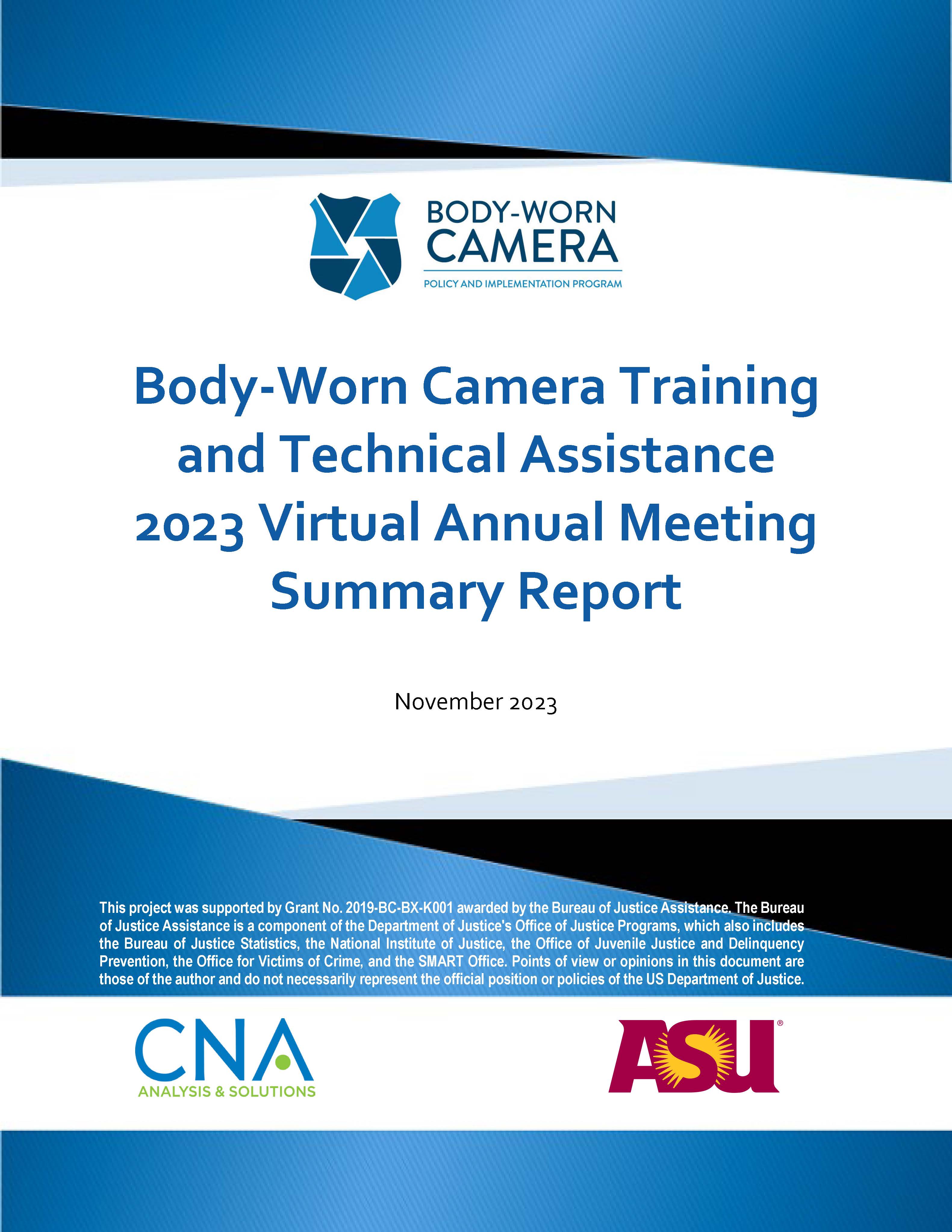
To review participants' discussions and lessons learned from the meeting, new ideas for TTA, and evaluation feedback from the attendees, access the BWC TTA Virtual Annual Meeting Summary Report here.
This meeting was once again held in a virtual format. Each of the 2023 Virtual Annual Meeting training sessions were recorded, and you may access the session slides by clicking on the links below:
Session Title, Session Description, & Materials

Day One - Welcome and Introductions
Watch the welcome and introductions here.

National Organizations' Perspectives on BWC Implementation and Next Steps
In this session representatives from NPI and PERF discussed perspectives on BWC implementation, utilization, and the roles BWCs play in public safety.
Access the slides here.
Access the presentation here.
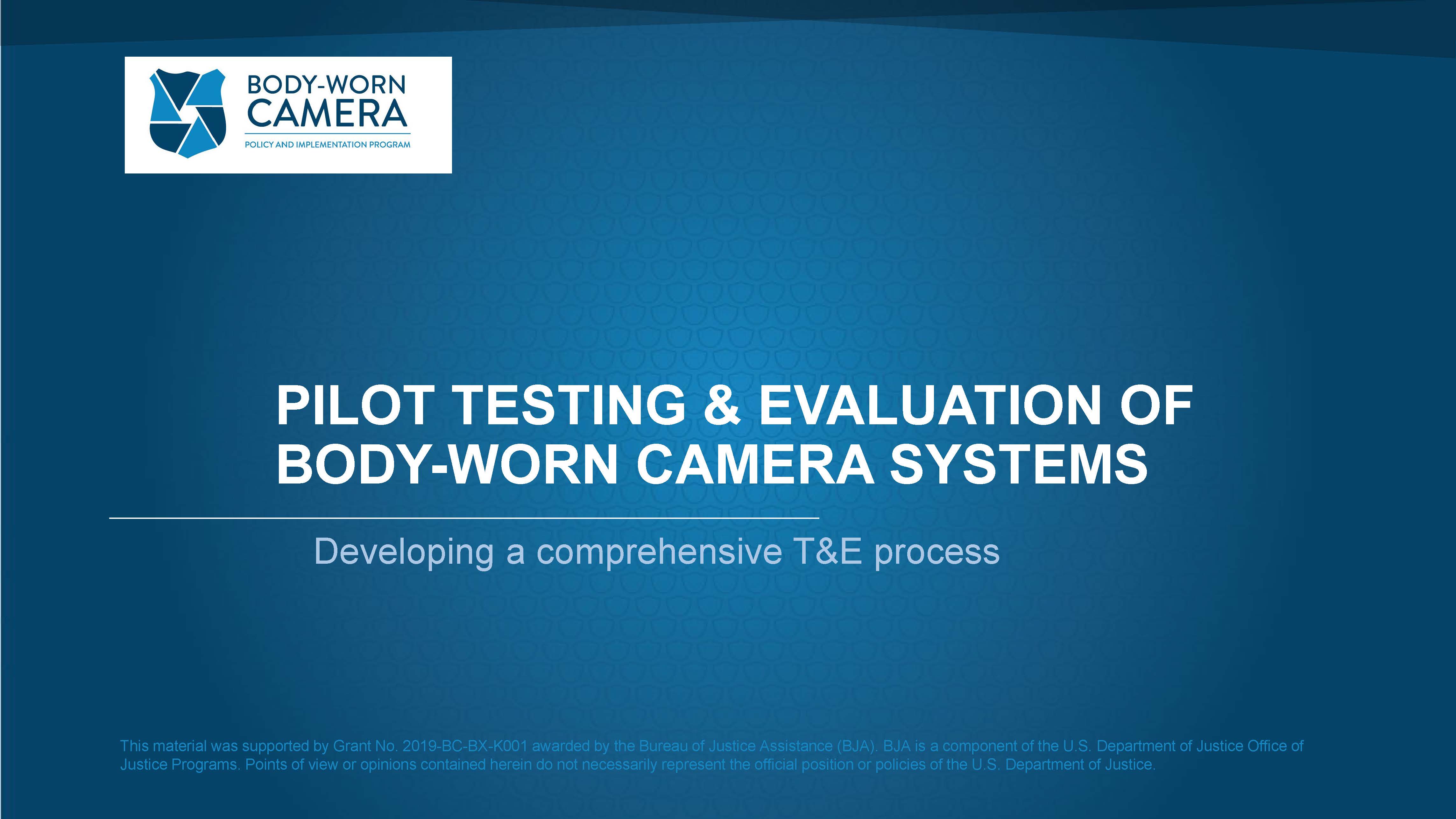
Pilot Testing and Evaluation of BWC Equipment
During this session, BWC TTA SMEs Geoff Smith and Charles Stephenson discussed challenges and best practices associated with testing and evaluating BWC equipment prior to procurement. Representatives from the Henderson (NC) Police Department and the Cuyahoga (OH) Metropolitan Housing Authority discussed what they did to test and evaluate equipment, as well as how that informed their camera purchases and BWC programs.
Access the slides here.
Access the presentation here.
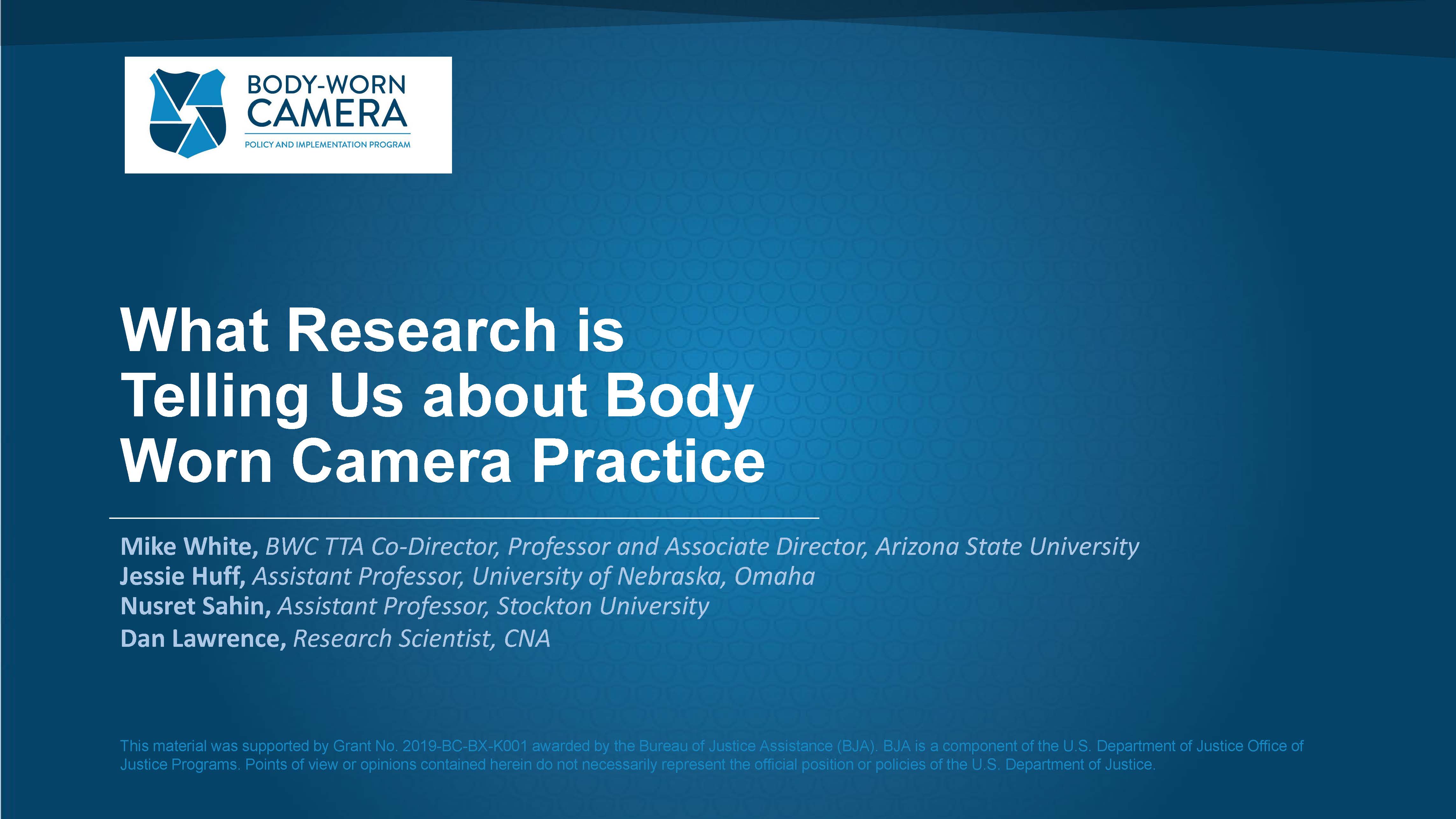
What Research is Telling Us about BWC Practice
Dr. Huff discussed findings from a study of Phoenix Police Department data regarding whether there is notable variation in officer-level BWC activation rates across officer characteristics, features of officers’ assignments, and other indicators of police performance. Dr. Sahin discussed findings from two studies, one involving the impact of BWCs on the adjudication of citizen complaints, and the other on the impact of BWCs on Enhancing Procedural Justice Through Substantiation, or his EPJETS model. Dr. Lawrence discussed findings from three studies.
Access the slides here.
Access the presentation here.
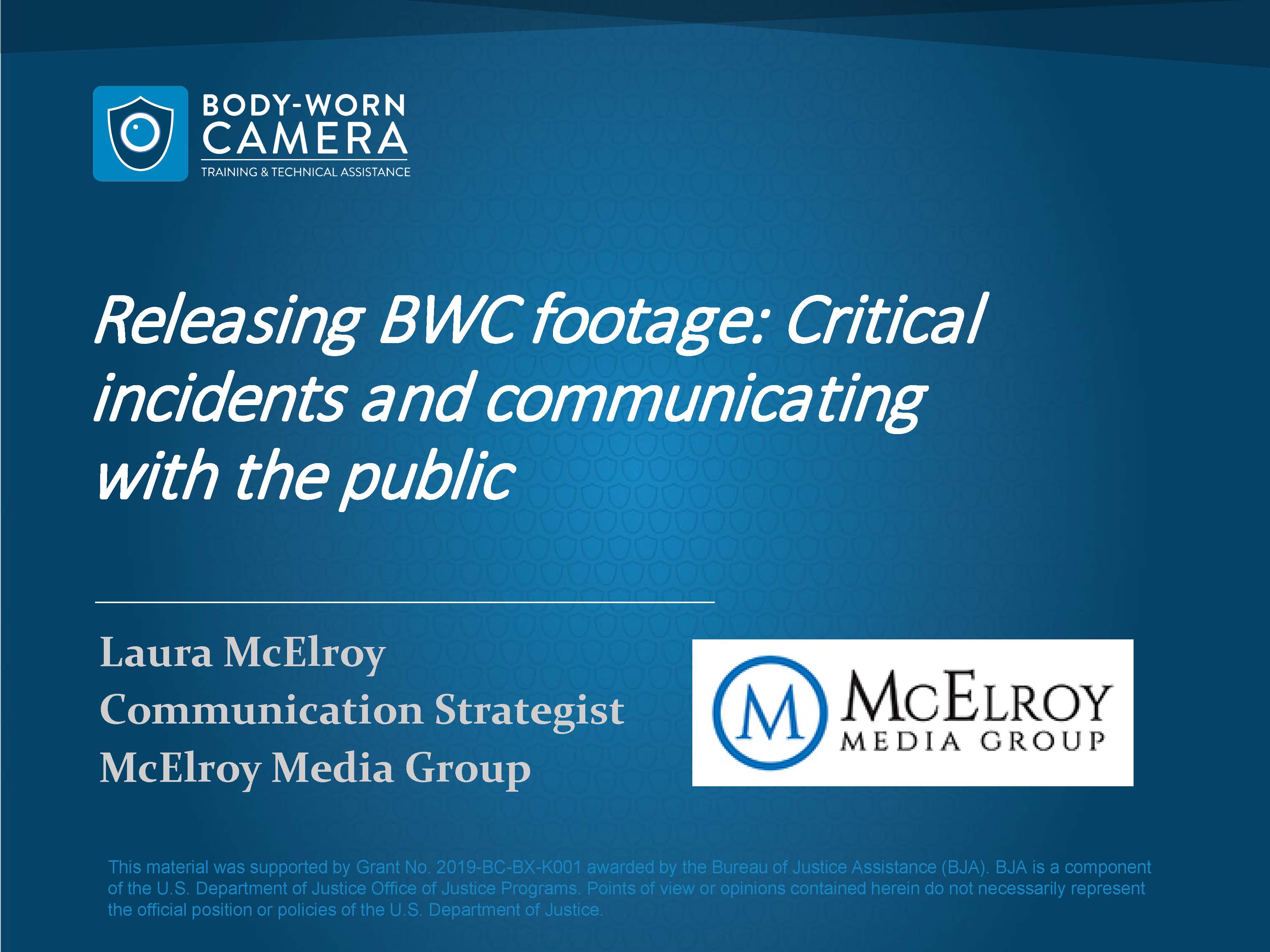
Releasing BWC Footage: Critical Incidents and Communicating with the Public
In this session, communications strategist Laura McElroy discussed the release of BWC videos, offered strategies for how to communicate with the public following a critical incident, and provided the media perspective.
McElroy discussed her idea of “communicating to build community,” leveraging social media and local media and managing critical incidents. She also discussed the importance of developing a preemptive Crisis Communication Plan, which involves 16 steps to achieve those goals.
Access the presentation here.
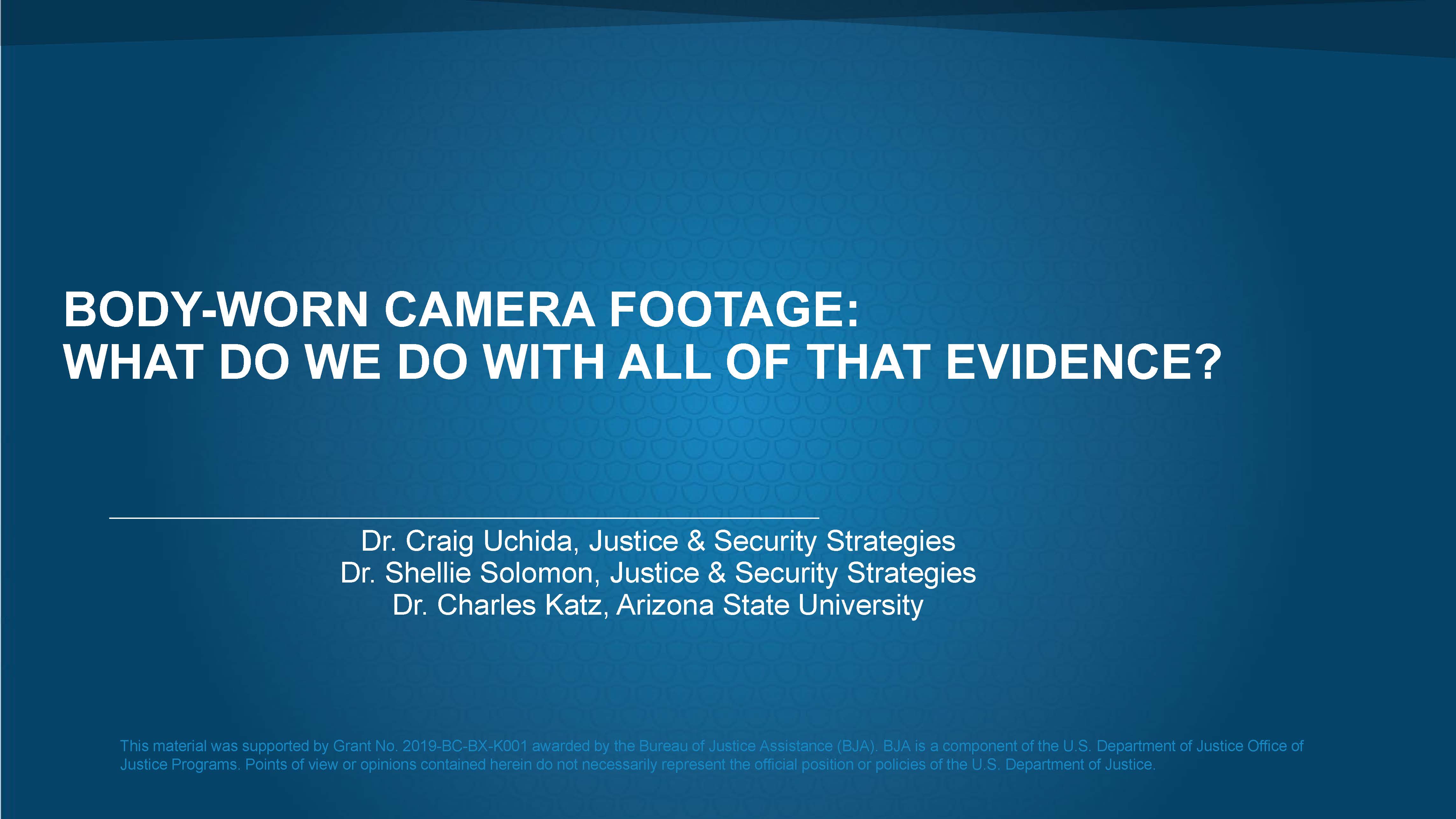
Digital Evidence Management: What Do We Do with All the Footage?
In this session, Dr. Craig Uchida, Dr. Shellie Solomon, and Dr. Charles Katz discussed BWC footage and BWC metadata, focusing on the ways it is used within police departments and prosecutors’ offices. They shared insights from three BWC sites: Phoenix, Arizona, and two agencies in South Florida (Broward County Attorney’s Office and Fort Lauderdale, Florida).
Access the slides here.
Access the presentation here.

Promoting Constitutional Policing Through the Use of BWC Footage
This session reviewed the ways that BWC footage has been helpful in improving police officer conduct and in enhancing the links between BWC footage, police officer training, and performance reviews.
Access the slides here.
Access the presentation here.
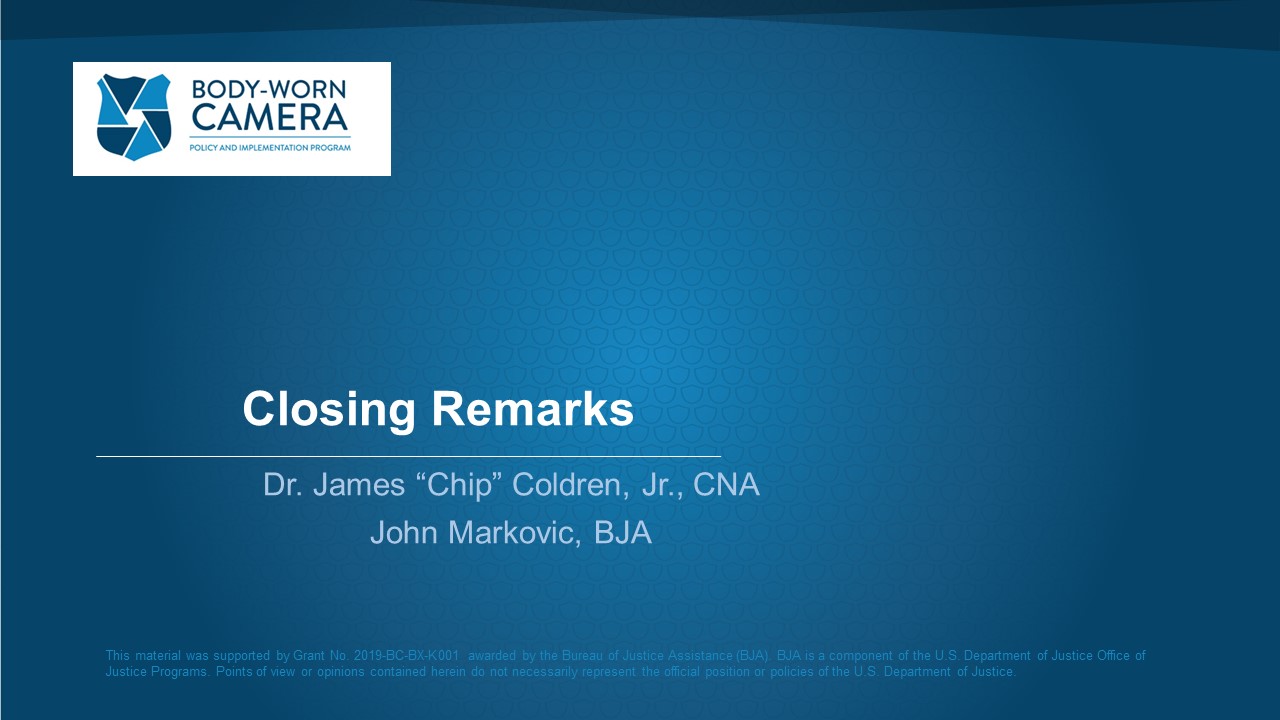
Day One Closing Remarks
Access the presentation here.
Day Two
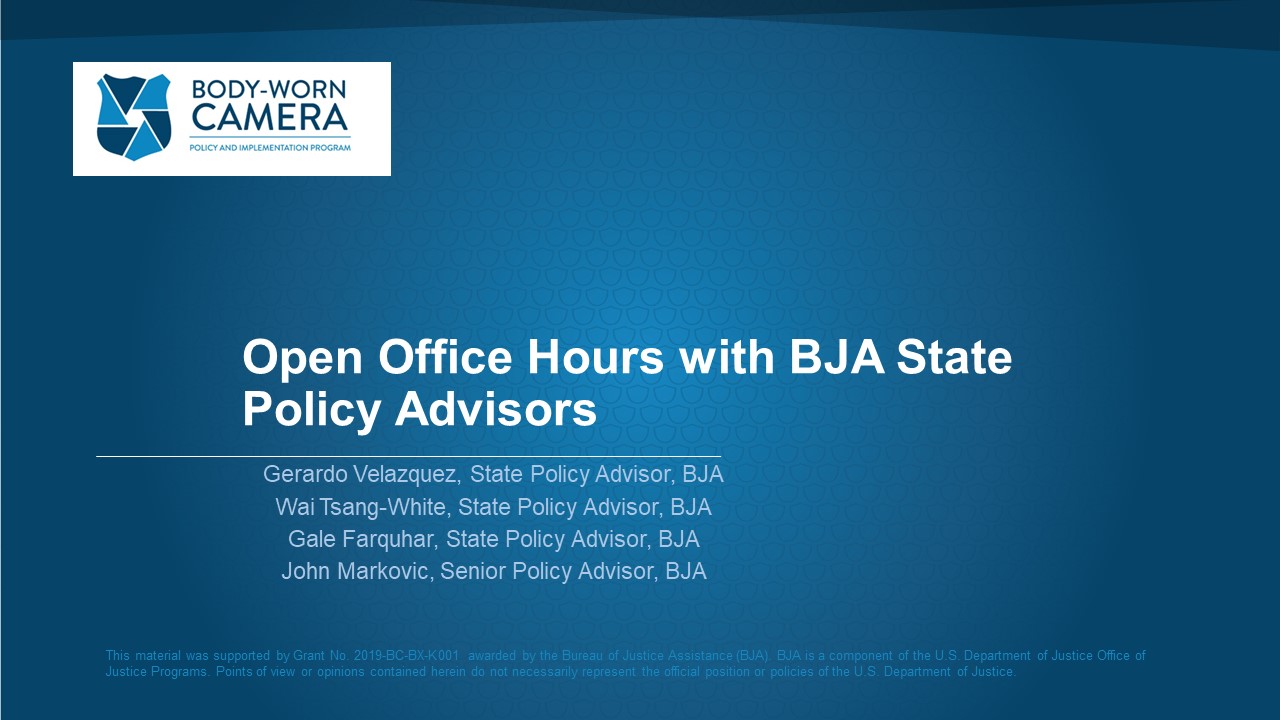
Q&A/Office Hours with BJA State Policy Advisors & JustGrants
BJA State Policy Advisors held open office hours to answer questions from BWCPIP grantees.
Access the presentation here.

Keynote Speaker: LAPD Chief Michel Moore
Chief Michel Moore of the Los Angeles Police Department (LAPD) discussed benefits, how to mitigate challenges, lessons learned, and the utilization of BWCs as it relates to improving public safety, reducing crime, and improving public trust between police and the citizens they serve. During a question-and-answer session with the audience and Dr. Craig Uchida, Chief Moore answered important questions concerning initial implementations and considerations for a BWC program, the public release of footage, and the new frontier of AI and machine learning with BWC video.
Access the presentation here.
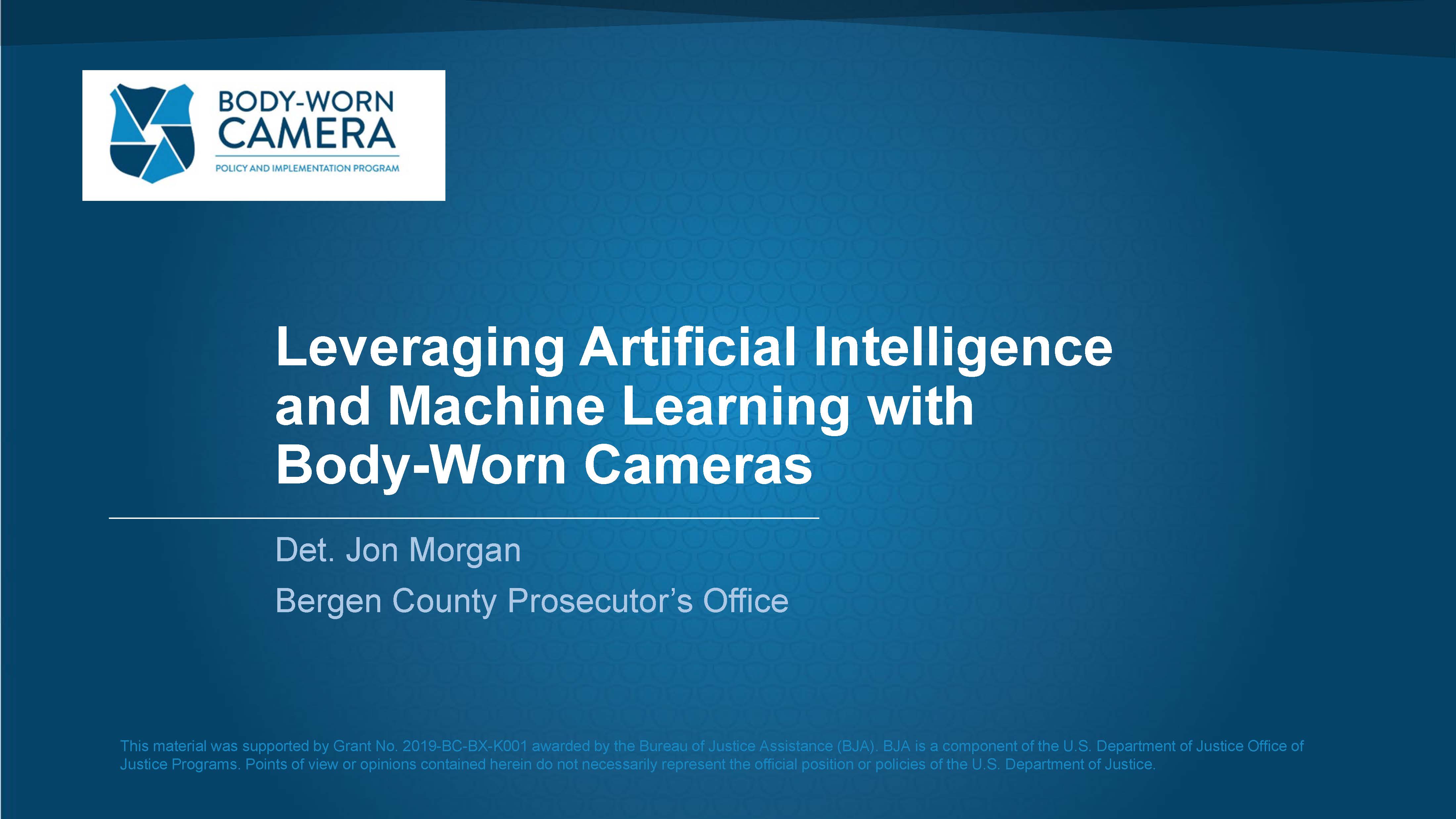
Utilization of and Perspectives on Analytical Tools and BWC Footage
In this session the presenters discussed body worn camera footage and the way in which the footage is used within police departments and prosecutors’ offices. Panelists provided expert opinions on the rapidly changing climate of digital evidence management and its ever-growing importance in the world of law enforcement. As agencies across the country continue to accept and adopt body worn cameras it has become essential that they craft policies and procedures which guide agencies through critical incidents that garner significant public interest.
Access the slides here.
Access the presentation here.
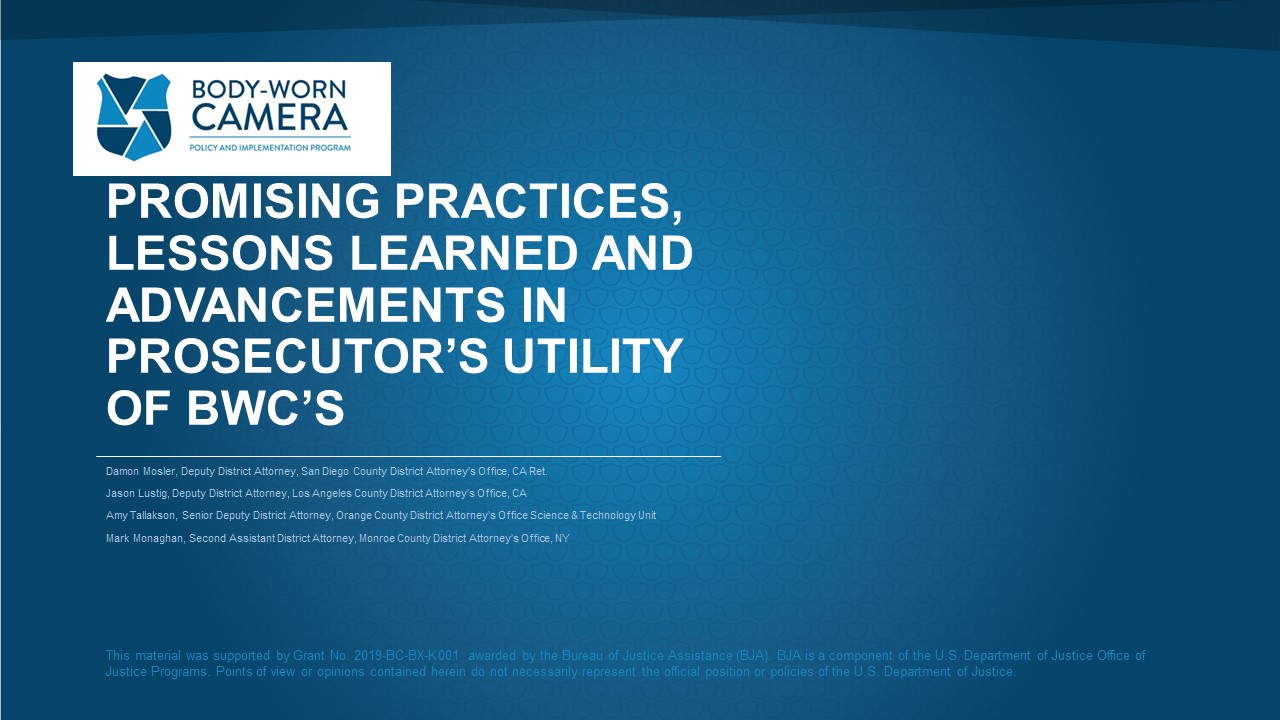
Promising Practices, Lessons Learned, and Advancements in the Use of BWCs by Prosecutors
This session focused on BWC footage and the way it is used within police departments and prosecutors’ offices. During the session, participants heard from panelists regarding lessons learned, best practices, and considerations for managing and utilizing BWC footage from a prosecutor’s perspective.
Access the presentation here.

Understanding the Federal Procurement Process
This session, led by Ira Scot Holmes, Edith Sunga, and Angela Wade of OJP, provided a brief overview of the federal procurement requirements for BWCPIP grantees and answered questions from attendees.
Access the slides here.
Access the presentation here.
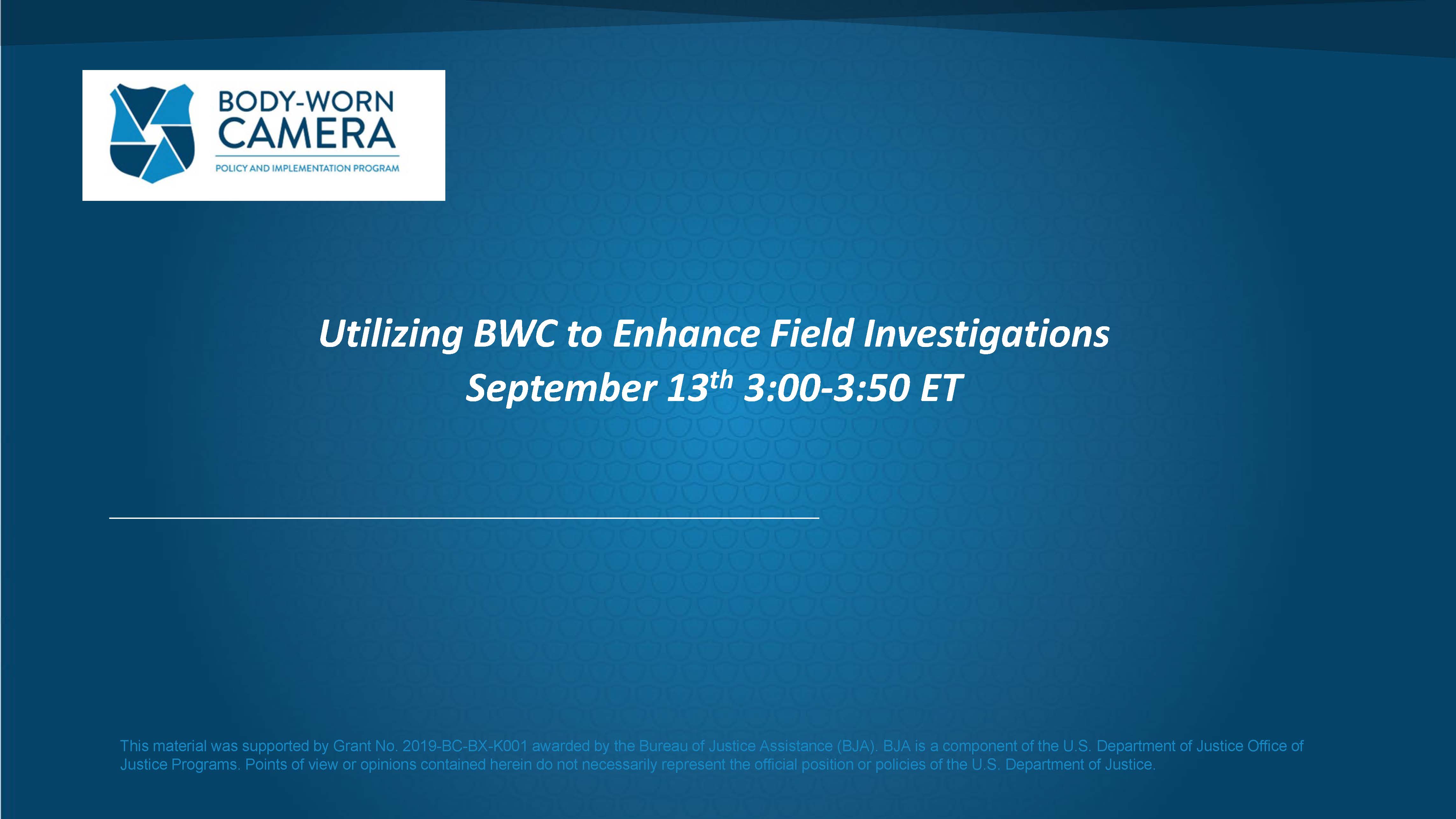
Using BWCs to Enhance Field Investigations
Law enforcement agencies increasingly recognize that BWCs and digital evidence can assist with investigations in ways that were not commonly considered during initial implementation. This session highlighted how some agencies have taken advantage of BWCs to enhance their investigations in the field, using methods and approaches that can be considered by other agencies.
This session followed a Q&A format with Tom Woodmansee moderating and participants Christian Quinn, DDA Jason Lustig, and Lt. Chris Johnson participating in discussion topics.
Access the presentation here.
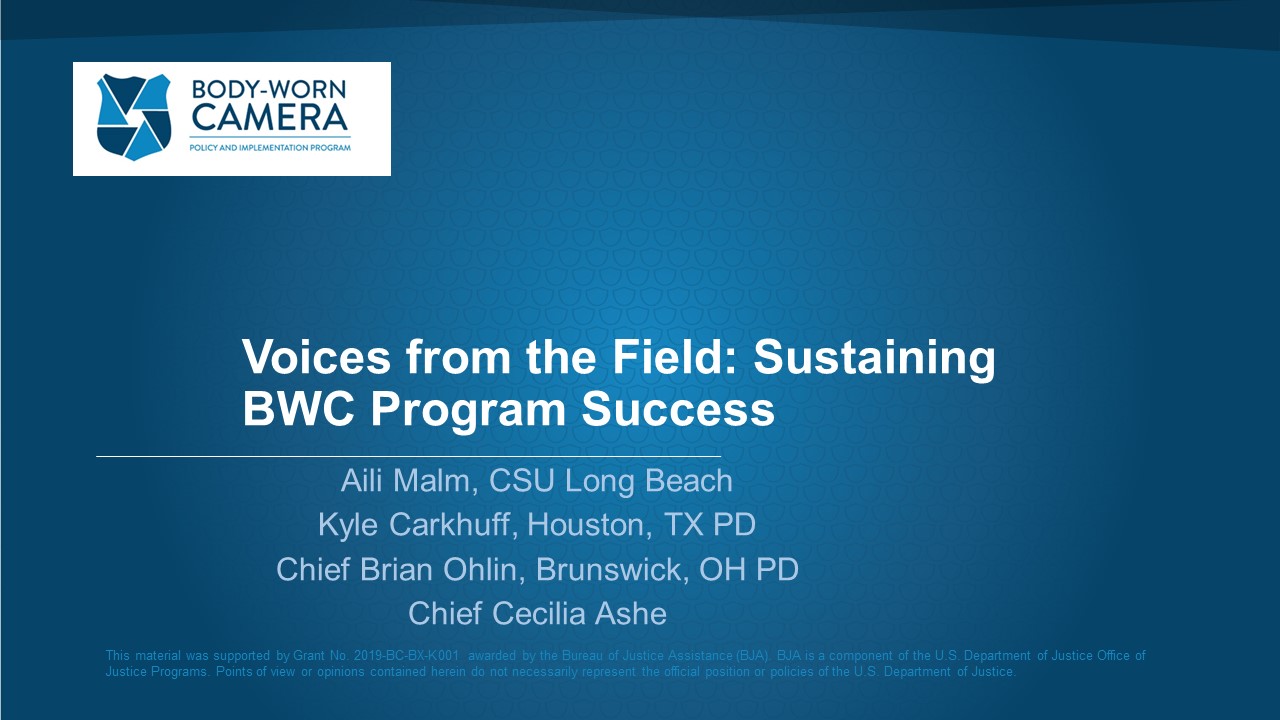
Voices from the Field: Sustaining BWC Program Success
This session discussed best practices for sustaining a successful BWC program. In this session, panelists heard from several BWCPIP sites (Brunswick, OH; Houston, TX; and Milford, DE (Chief Ashe was a former BWCPIP grantee when with Wilmington PD) about the implementation of their BWC programs and how they have sustained success with their programs long after initial implementation.
Access the presentation here.
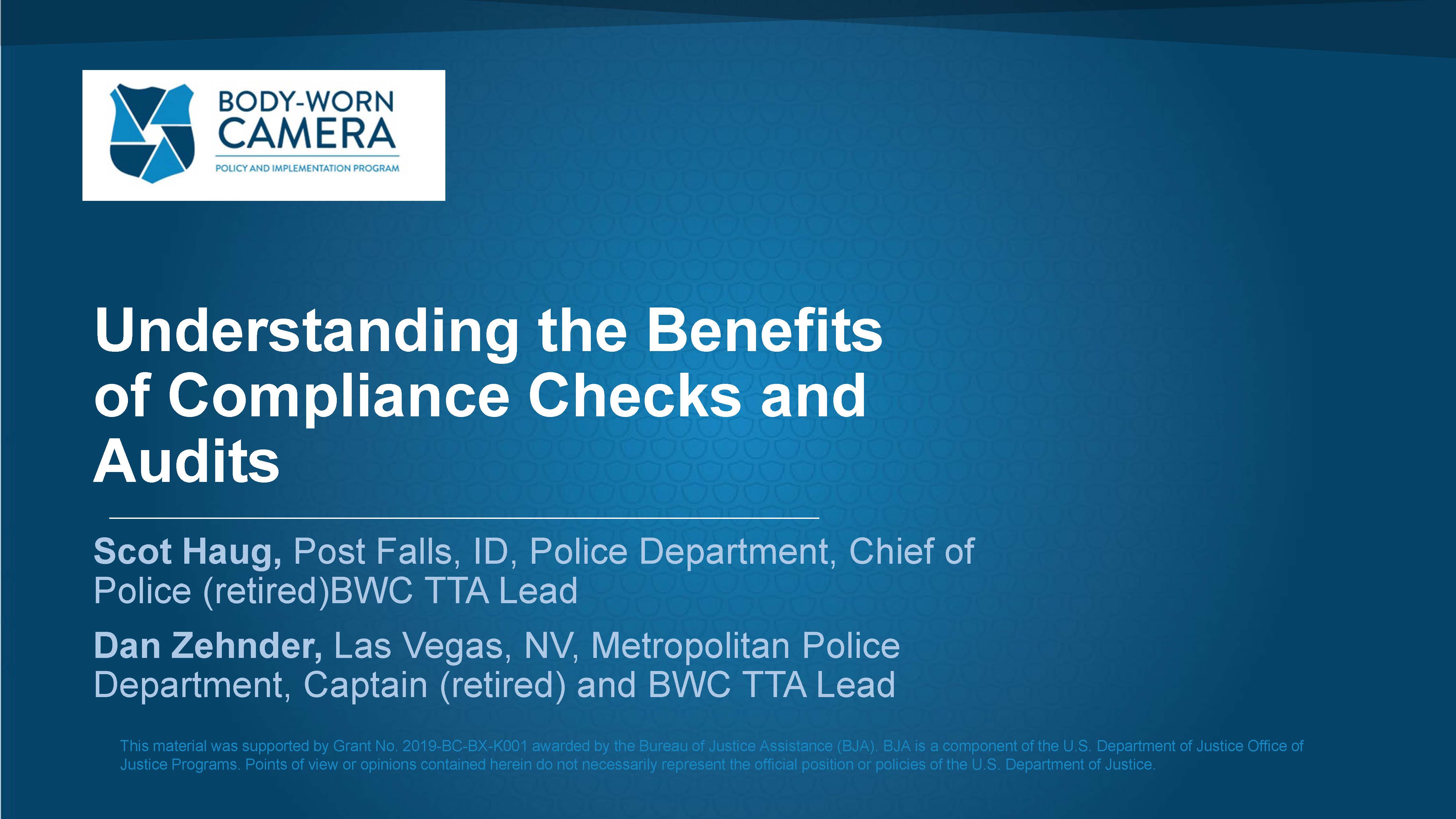
Understanding the Benefits of Compliance Checks and Audits
This session, led by BWCTTA SMEs Scot Haug and Dan Zehnder, focused on issues, concepts, and approaches to reviewing BWC videos for policy compliance and program auditing.
Access the slides here.
Access the presentation here.

Day Two Closing Remarks
Access the presentation here.
Day Three
BJA Performance Measurement
This presentation explored how BJA uses performance measures to assist grantees, improve BJA programs, enhance decision-making, and report to Congress on how funds are spent.
Access the presentation here.
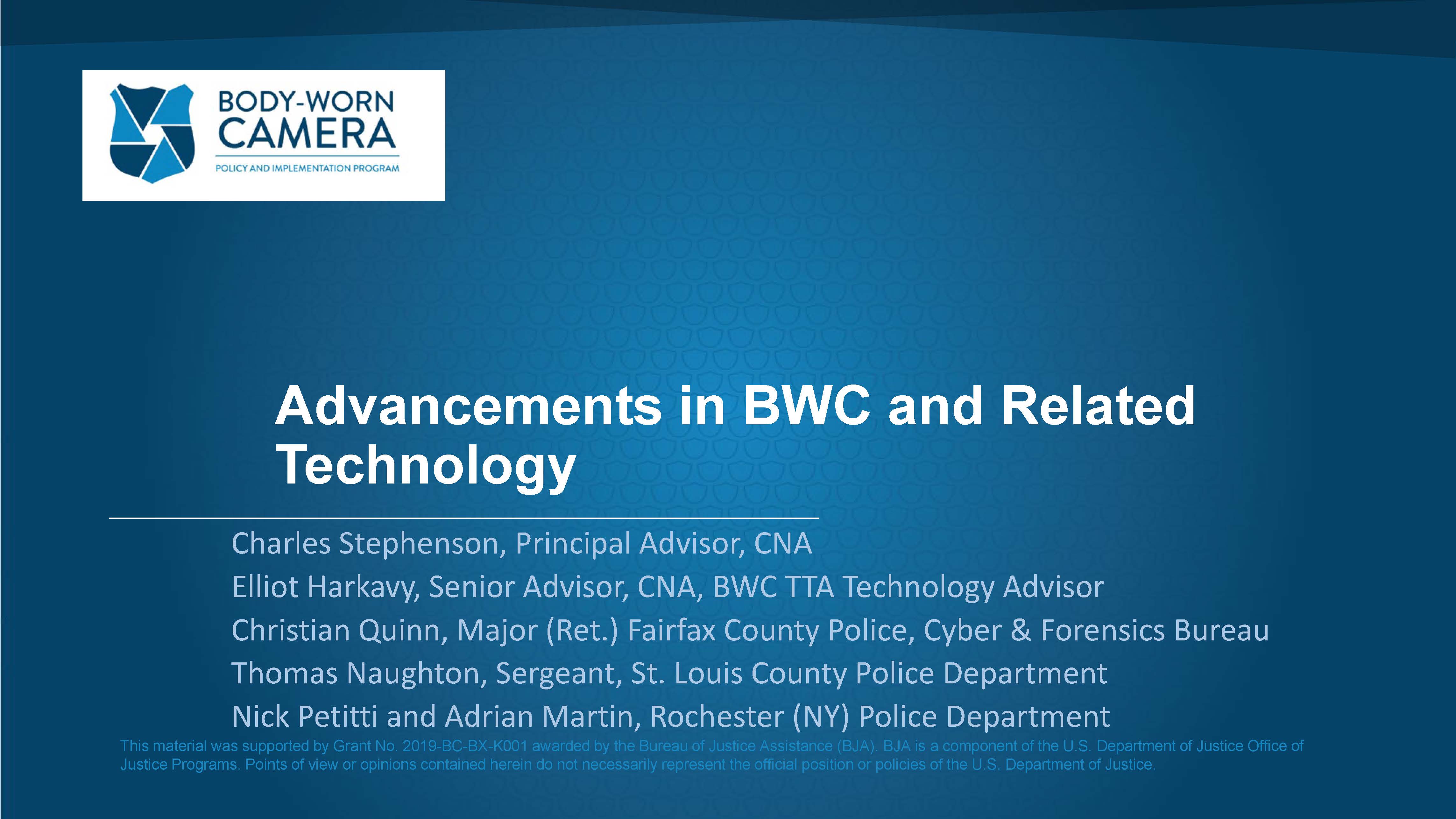
Advancements in BWC and Related Technology
This session presented a panel discussion on changes in BWCs and other related technology over the last six years. As with other technologies, BWCs evolve and change rapidly. Discussion focused on the current state of the BWC technology, the lessons learned from procuring and deploying BWCs, and the realities of integrating BWCs with other technology systems.
Access the slides here.
Access the presentation here.

BWC Tagging
BJA's John Markovic and the BWC TTA Director Dr. James "Chip" Coldren will discuss lessons learned over the past five years of BWC implementation and technical assistance delivery, touching on such issues as digital evidence management, maturation of BWC programs, and emerging needs for technical assistance.
Access the slides here.
Access the presentation here.
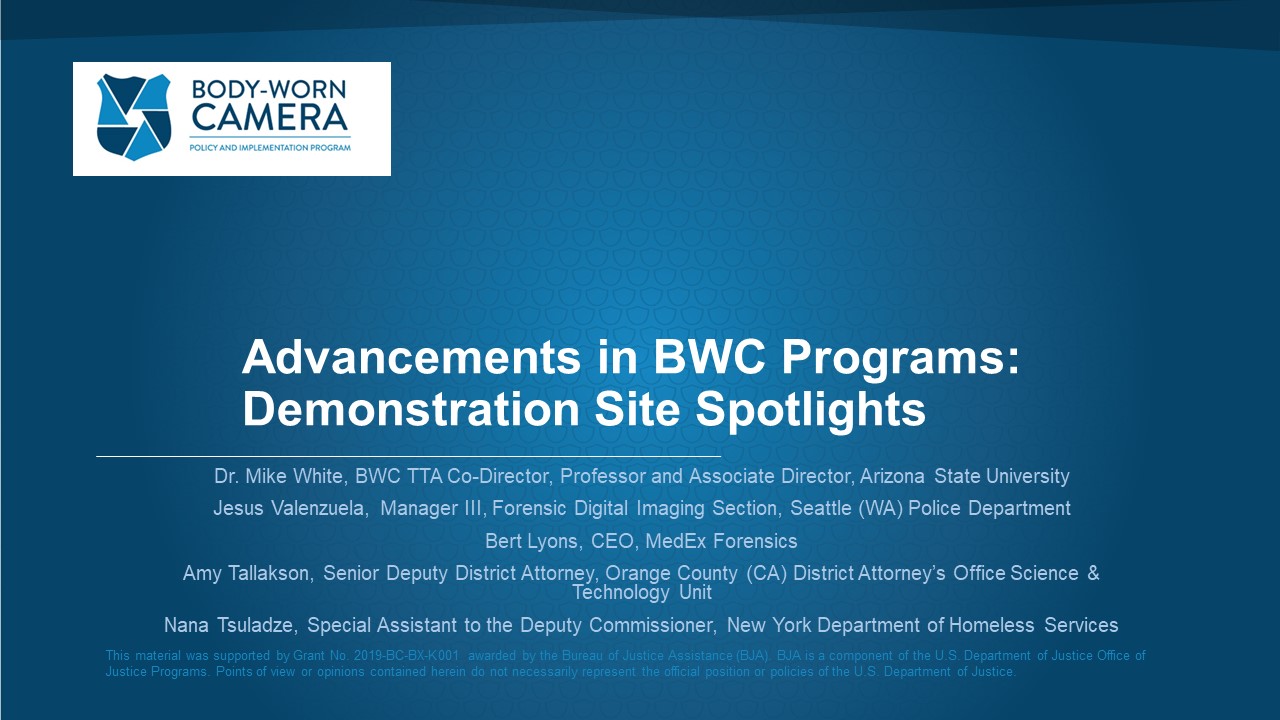
Advancements in BWC Programs: Demonstration Site Spotlights
This session highlighted advanced BWCPIP projects from three special BWC demonstration site categories (Category 3: Digital evidence management, Category 4: Prosecutor or DA office, and Category 5: Focus on constitutional policing). Grantees discussed the evolution of their BWC programs, emphasizing the unique successes and contributions their projects make to the field. Jesus Valenzuela discussed the process of transitioning from one DEM platform to another. Bert Lyons talked about the collaboration between Seattle PD and a vendor to achieve integration goals. Amy Tallakson shared some of the Orange County DA’s office’s experiences as they work towards integrating DEMs, and Nana Tsuladze discussed the New York City Department of Housing’s PD’s (NYCDHSPD) constitutional policing efforts through training.
Access the slides here.
Access the presentation here.

Remarks from BJA Director Kahrlton Moore
BJA Director Moore discusses BJA’s evolving commitment to support BWCs in state, local, and tribal law enforcement agencies and adaptations being considered for future grant cycles.
Access the presentation here.

Using Body-Worn Cameras to Improve Organizational Response to Civil Unrest
This session highlighted the benefits and considerations of using BWC footage in civil unrest after-action reviews and provided recommendations for incorporating them in organizational reviews of future significant events.
Access the presentation here.
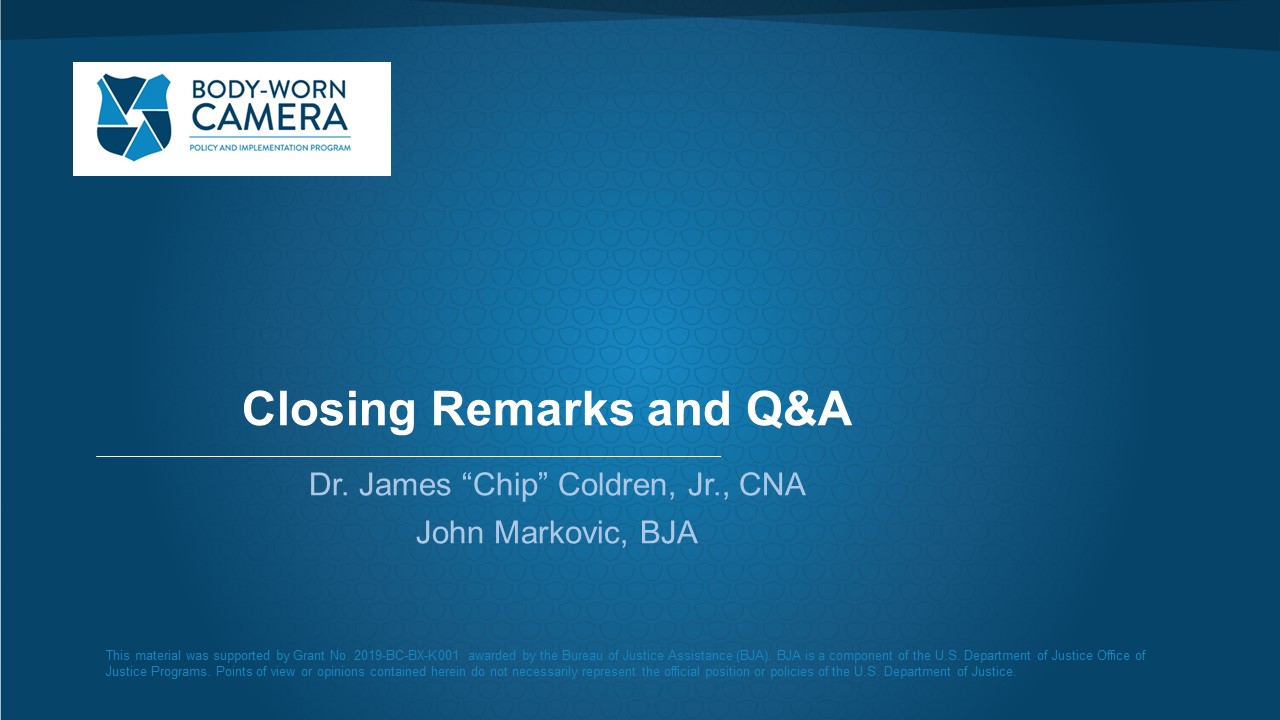
Day 3 Closing Remarks
The BWCPIP program team leadership provided a brief summary of the meeting and discuss key takeaways. Leadership will discuss any training and technical assistance needs of participating agencies and responded to questions and suggestions from attendees.
Access the presentation here.
